In today’s hybrid work model, people want to work where and when they want. Workplace occupancy sensors help organizations make data-driven decisions about occupancy levels, availability, and space utilization. Understanding the different sensor technologies, capabilities, and features is the first step in creating an office that optimizes space utilization and efficiency, and values worker satisfaction.
What are Occupancy Sensors & How Do They Work?
Workplace occupancy sensors detect when a space is being used. Based on movements or other measures, they can trigger a series of events like turning the lights on or off. There are generally five types of occupancy sensor technology:
1. Passive Infrared (PIR)
PIR sensors detect heat emitted by people in motion. The technology can only see movement in its line of sight and won’t capture people behind obstacles, partitions, or glass. It works best in single-use bathrooms, storage closets, small offices, etc.
2. Ultrasonic
Ultrasonic sensors work similarly to the doppler effect or echolocation used by dolphins and bats. Sensors emit high-frequency signals and detect changes in frequency from motion. The frequency is high enough that the human ear and hearing aids don’t notice it. These sensors don’t have a line of sight, so they’re better for restrooms with stalls or large common areas.
3. Radar/Microwave
Radar sensors (also called microwave sensors) work similarly to ultrasonic units but use electromagnetic waves. Electromagnetic waves travel faster than sound waves, so they can detect smaller motions. Radar sensors sense movements like typing and breathing that would evade detection from other sensors. They’re best for large spaces and challenging environments, like the outdoors.
4. Bluetooth Low Energy (BLE) Beacons
BLE beacons pulse out signals that can be broadcast to smartphones and sensors in the area to monitor indoor spaces. It is commonly used for wayfinding, access controls, and door entries.
5. Optical Sensors
Optical Sensors pair computer vision technology with artificial intelligence and capture low-resolution images of a space. They can detect intrusion attempts and trigger alerts to security staff, turn on lights, send audio warnings, and more.
Office Occupancy Sensor Applications
Using a combination of four different applications for office occupancy sensors will enable you to collect valuable space utilization data. Meeting rooms, open offices, hot desks, storage closets, stairwells, and common areas require different sensor configurations for the most cost-effective and accurate solution.
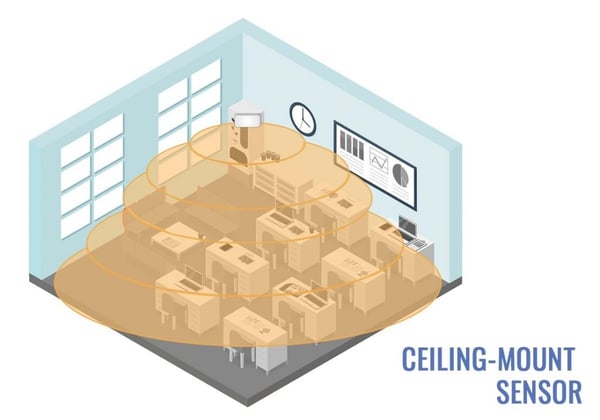
Ceiling-Mount Sensor
Ceiling-mount occupancy sensors are ideal for larger spaces like lobbies, cafeterias, coworking areas, and large board rooms. You may need to install several to cover the entire area. They can collect information like footfall traffic and give insight into where people congregate, whether they use open meeting areas, and which areas are often empty.
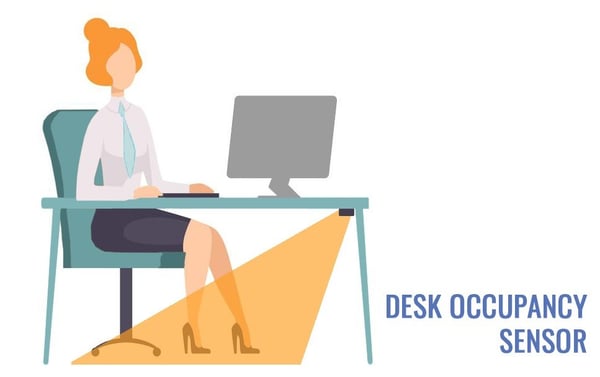
Desk Sensor
For highly-accurate, real-time data, desk sensors are the way to go. They’re usually battery-powered and mounted under individual workstations. Desk occupancy data is then transmitted wirelessly to the cloud. They’re ideal for desks, flex-spaces, cubicles, and small huddle rooms, and are highly reliable. Real-time sensors can show available workspaces and trigger cleaning alerts when people leave.
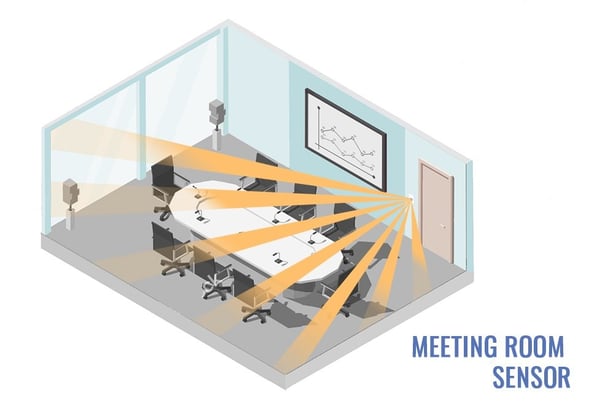
Meeting Room Sensor
Meeting room sensors provide insight on current occupancy status, usage trends, and control room settings. Instead of walking around looking for a free space, you can rely on real-time data to find unoccupied meeting rooms. When you enter, lights will adjust, displays will turn on, and the room will automatically be marked as unavailable.
These low-profile sensors are typically placed on the ceiling or over doors and rely on PoE (Power over Ethernet) to run and transmit data.
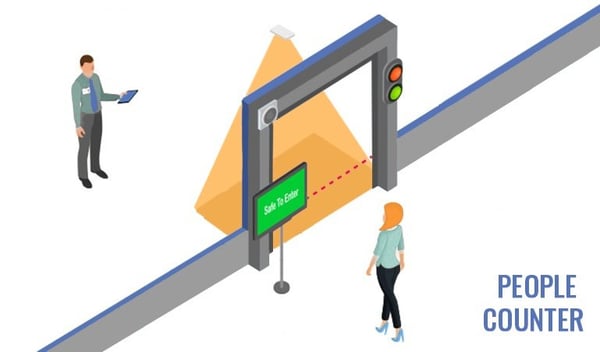
People Counter
Some sensors count people in a space and help you understand footfall patterns. They can also provide detailed insights into space utilization. Is your large conference room usually booked for meetings with two or three people? How many employees use the break room, and at which times?
People counters differ from occupancy sensors because they use object recognition to detect how many people go in either direction. Only anonymous data is collected so no personally identifiable information is stored. They run on PoE or the main power supply.
Benefits of Occupancy Sensors
Efficient Hot Desking
Whether it’s your office or a coworking space, knowing desk availability will help streamline hot desk procedures. People can book unoccupied workspaces; when they leave, a cleaning alert can trigger the janitorial staff, and the desk will be available for someone else.
Save on Utilities (+Save the Environment!)
Utilities are expensive, and lighting an unused office is a major waste of money and resources. Automating lights to turn on/off based on occupancy can conserve energy and reduce utility costs.
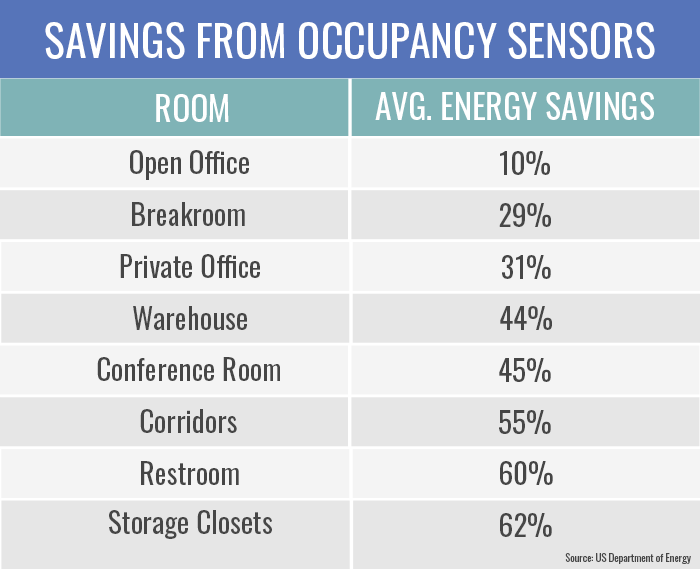
Improve Space Utilization
Reviewing historical data can give insight into how your space is used. Perhaps two of your conference rooms are only used 10% of the time, or several rows of cubes are occupied for 15% of the time. Do you need the extra square footage, or could it be repurposed, consolidated, or eliminated? Space utilization sensors provide the data you need to make informed decisions.
Attract and Retain Top Talent
Knowing how employees work is essential to creating spaces that foster creativity, productivity, and job satisfaction.
- Learn what type of environments employees prefer to spend time in and make more of them
- Adjust the lighting, blinds, and temperature to improve employee well-being
- Provide real-time information to keep them engaged and informed about available spaces
Automation
Occupancy sensors gained their reputation for automatically turning lights on or off, but they can do even more. Integrate with additional platforms to:
- Turn on/off conference rooms (lights, projectors, displays, etc.)
- Adjust HVAC settings
- Restrict access to a room once it reaches maximum occupancy
- Update hot desk and meeting room availability
- Trigger cleaning alerts
Data-Driven Decisions
Take the guesswork out of building control and make data-driven decisions about floor space, square footage, layouts, and more. Facility managers can demonstrate value to stakeholders and leadership teams by collecting data to support their decisions.
Healthier Spaces
Occupancy sensors can create healthier spaces, making the environment more comfortable for employees by controlling lighting, air quality, and temperature. Access control integrations can limit the number of people in a space, and automated cleaning alerts ensure rooms are regularly maintained.
Important Occupancy Sensor Features
We’ve covered various applications for occupancy sensors. Still, when you throw brands into the mix, the options can become overwhelming. To narrow down your search, consider the following features you need and let those guide your decision-making process. An experienced technology consultant can help you select a product with the highest ROI and efficiency.
Wired or Wireless
Wireless occupancy sensors offer more flexibility and are easier to install. However, you must check and replace the batteries, which may wind up costing more over time. Try to find batteries with a minimum lifespan of two years. PoE (Power over Ethernet) is a popular option in smart buildings because you don’t need a separate power supply installation.
Accuracy
The old adage “you get what you pay for” is true for occupancy sensors. Cheap sensors lack accuracy and are more prone to false triggering, potentially negating any cost savings. We recommend a minimum of 98% accuracy for commercial environments.
Ceiling vs. Wall-Mount
Wall-mounted sensors generally have a manual trigger option that gives users an extra level of control. But they typically have limited reach and don’t fare well in larger spaces. Ceiling mounted sensors remove the manual trigger but offer 360-degree coverage.
Integrations
What do you want your occupancy sensors to do? Does it need to communicate with additional platforms? To integrate with third-party software, you need to select an application with an application programming interface (API).
Real-Time, Accurate Data
Do you want to look at historical usage trends? Or do you need real-time occupancy data to power room schedulers and wayfinding applications? Some sensors report periodically, while some offer real-time updates. Make sure yours provides the sensor data you want when you need it.
Physical Placement and Appearance
White, black, shape, profile, placement…these will impact the overall look and feel of the device. You don’t want it to be obtrusive, make people uncomfortable, or get accidentally damaged.
Occupancy sensors have become synonymous with smart buildings. The right combination of sensors, integrations, and data analytics can help you cut costs, reduce your carbon footprint, improve employee well-being, and automate processes.
System selection and placement are crucial to an effective platform, but pricing can vary widely depending on your needs. Gain a deeper understanding of how to budget for such projects using our helpful guide below. If you’d like to speak with a professional about outfitting your space, contact us.




Leave a Comment